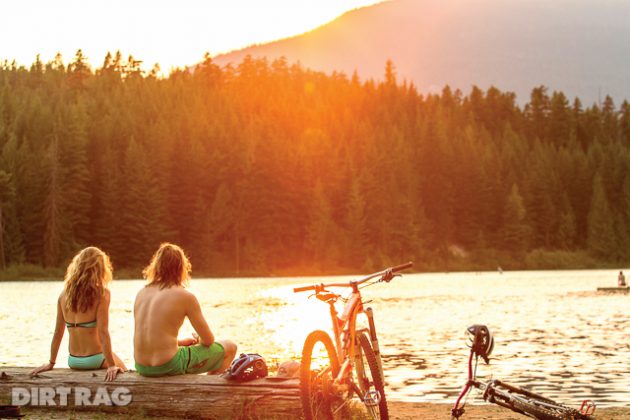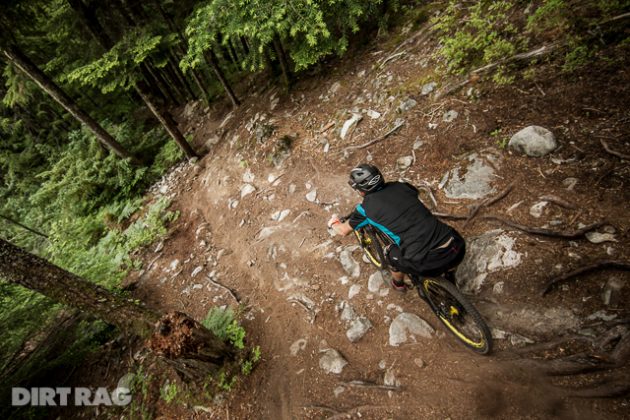Beyond the Bike Park: Whistler, Canada
Originally posted on May 12, 2016 at 12:30 pm
Words: Hailey Elise
Photos: Mark Mackay
Originally featured in Issue #190
She’s elusive. Cheeky, only showing glimpses of her true nature the farther in you find yourself. And by farther in think of an hour climb. Whistler’s trail systems are easily accessed by those who are looking for them, but outside of the bike park they require a mindset of going on an adventure. Beautiful, extreme and a few pedal strokes away, the established network can provide a great ride while allowing for exploration of Whistler’s wilderness.

With a history extending almost 30 years in the making, the trails spanning the Whistler Valley have evolved alongside the modern-day mountain bike. As technology advanced, so did the trail building, leading to new-school trails that are feeding the current trend among gravity riders of earning your turns.
History
With mountains set before them, rogue builders went in search of downhill descents in Whistler as early as the 1980s to escape the boredom of the offseason from skiing. The first trails can be traced back to decommissioned logging roads that provided access to the hills surrounding the valley. Trails such as the challenging Binty’s were carved into the mountainside using dirt bikes and chain saws. Many of the skeletons of trails created by these first builders laid the foundation for the trails we know today.

While mountain bike technology improved and the sport grew, trail building increased throughout the Resort Municipality of Whistler. With that came conflict and the need for maintenance, regulation and supported growth. The trails were soon faced with potential closure, and The Whistler Off Road Cycling Association, or WORCA, came to be in 1989 to lobby against the bike trails being shut down.
River Runs Through It, Cut Yer Bars and other infamous trails became established shortly after the founding of WORCA. The acknowledgment of biking as a recreational resource for the area translated into increased building, participation and trail traffic, in turn laying the building blocks for Whistler’s extensive world-class riding.

New Directions
Driven by the progression of the sport and technological advances in mountain bikes, modern-day trail builders in Whistler have been creating descents that have been putting Whistler on the map for riding well outside the bike park. One such trail builder is Paul Stevens, co-builder of Blackcomb’s Micro Climate, a trail containing a little bit of everything from steep to flow and every bit worth the climb. His initial inspiration came from Dave Anderson, fellow rider and co-builder of the trail, who skied the zone in the winter and felt the terrain would be perfect for riding a bike down.

The following summer, the two flagged the line and Micro Climate began. Upon completion, the trail gained a lot of traffic. What’s more, the Enduro World Series was making its debut at the 2013 Crankworx. Developers wanted to showcase the best riding Whistler had to offer as well as release a course that would surprise even the locals. The inclusion of Micro Climate helped set the stage for the Whistler round of the EWS to be known for challenging and exciting riding.

Expanding Zones
WORCA, along with new builders, is expanding the horizons of Whistler’s biking scene to the surrounding mountainous zones, such as Wedge, Sproatt and Whistler. In addition to an extra-long descent, the creation of trails that connect subalpine regions to well-known recreational areas allows for an adventurous ride down through the stunning forest zones of British Columbia’s Coast Mountains. A bike rider now has the option of taking a full-day excursion or a leisurely few-hour jaunt.

When asked about the future of building and riding in Whistler, Stevens says that he thinks it is following the new-school style, which focuses on using the terrain more efficiently and emphasizes sustainability. Whistler is notorious for its rugged, technical and rocky landscape, but as building advances, more fl ow and jump trails have been popping up along the outskirts of the valley.
Stevens is also quick to note that with the transient population that goes along with being a resort town, involvement from people looking to build for their preferred style of riding could lead to some interesting trail innovations.

Culture
Together with progression and growth in trail building, the biking culture in Whistler has grown immensely. From WORCA-sponsored weekly rides to larger-scale events, mountain biking has become a recreational and social foundation for the Whistler area. Far more people, locals and tourists alike, are riding outside of the resort.
Climbing has become as sought-after as the world-renowned downhill singletrack, whether it’s for the fitness or the thrill. Social gatherings now take on forms ranging from epic day rides to after-work climbs. And one cannot forget the traditional post-ride visit to one of the many lakes.

The past, the present and the growing mountain biking culture have made Whistler a destination for all disciplines of riding. Although Whistler is most known for its incredible bike park, there is a whole other dimension that incorporates adventure, beauty and equally exciting trails. The mountains that line the village already harbor trails that will leave you wanting more, and the future looks bright for the surrounding regions.
“Intriguing, gorgeous and challenging” sounds just like the perfect soul mate, but in fact it’s Whistler’s trail systems. The only way to find out is to book a plane ticket and to experience for yourself, exploring the real Whistler.
